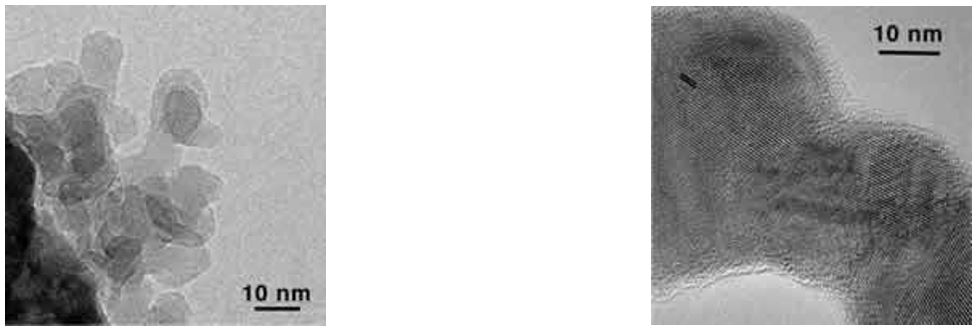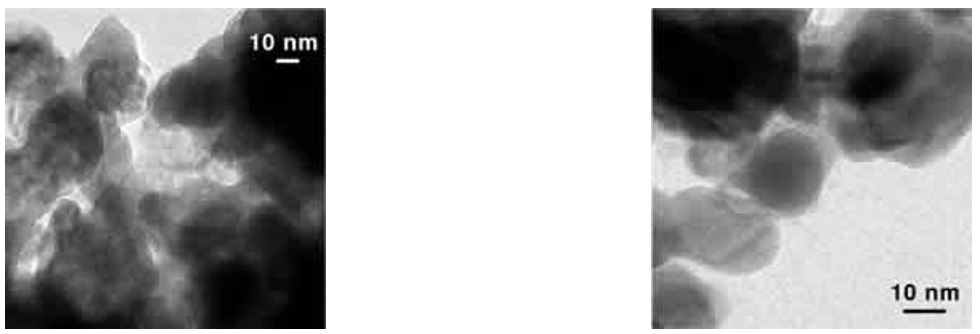Wet-chemical Synthesis
4.3.1 Synthesis in organic solvents
4.3.1.1 GaSb
In contrast to nanocrystalline nitrides and phosphides of the 13th group investigations to prepare nanocrystalline group 13-antimonides in solution are nearly unknown.[1] Chemical preparation methods are largely limited to traditional solid state-chemical methods such as melting of the pure elements or metathesis reactions. Thus, for example, AlSb, GaSb and InSb were prepared by reaction of MI3 (M = Al, Ga, In) with Na3Sb between 550 and 600 °C in autoclaves in the form of microcrystalline powders.[2]
An attractive wet-chemical synthetic method for binary III-V materials in solution was described for the first time in 1989 by Wells et al. Reactions of MCl3 (M = Ga, In) with E(SiMe3)3 (E = P, As) yielded the corresponding nanocrystalline materials.[3] Since then a number of other binary, nanocrystalline materials ME were synthesized according to this procedure.[4] This reaction sequence can be transferred to the synthesis of nanocrystalline GaSb. The reaction of GaCl3 and Sb(SiMe3)3 in organic solvents yielded nanocrystalline GaSb-particles, which show, as a function of the used solvent, different levels of contamination with elemental Sb and Si.[5]
Crystalline GaSb particles were obtained, as was face-centered cubic GaSb (sphalerite type) verified by electron diffraction and X-ray powder diffraction studies. The crystallinity of the GaSb-particles increases with increasing reaction temperature. Electron diffraction images of the GaSb-nanoparticles show Debye-Scherrer rings with d-spacings, which agree very well with literature values. While the level of Si/Cl-contaminations of the material decreases with increasing reaction temperature of the solvent, the size of the particles was found to constantly grows.[6]
All samples show the presence of agglomerates of smaller nanocrystallites. The particle size correlates with the boiling temperature of the solvent. Crystallites were obtained in pentane with a particle size of 10-15 nm, in hexane of 15 nm, in toluene of 25 nm and in xylene of 50 nm. Based on the SEM images the lattice constants of the crystallites were determined. Figure 1 illustrates exemplarily the d-spacings of 0.6 and 3.5 nm, which can be assigned to the planes (100) and (111) in cubic GaSb.
References
[1] See for example: a) T. J. Trentler, S. C. Goel, K. M. Hickman, A. M. Viano, M. Y. Chiang, A. M. Beatty, P. C. Gibbons, W. E. Buhro, J. Am. Chem. Soc.1997, 119, 2172; b) J. Jiang, A. K. Schaper, R. Schäfer, T. Hihara, J. A. Becker, Adv. Mater. 1997, 9, 343; c) Y.-D. Li, X.-F. Duan, Y.-T. Qian, L. Yang, M.-R. Ji, C.-W. Li, J. Am. Chem. Soc.1997, 119, 7869; d) Y. Xie, P. Yan, J. Lu, W. Wang, Y. Qian, Chem. Mater. 1999, 11, 2619.
[2] R. E. Treece, G.S. Macala, L. Rao, D. Franke, H. Eckert, R. B. Kaner, Inorg. Chem. 1993, 32, 2745.
[3] R. L. Wells, C. G. Pitt, A. T. McPhail, A. P. Purdy, S. Shafieezad, R. B. Hallock, Chem. Mater. 1989, 1, 4.
[4] See for example: a) M. A. Olshavsky, A. N. Goldstein, A. P. Alivisatos, J. Am. Chem. Soc. 1990, 112, 9438; b) S. R. Aubuchon, A. T. McPhail, R. L. Wells, J. A. Giambra, J. R. Bowser, Chem. Mater. 1994, 6, 82; c) J. F. Janik, R. L. Wells, V. G. Young, Jr., A. L. Rheingold, I. A. Guzei, J. Am. Chem. Soc. 1998, 120, 532; d) T. J. Trentler, S. C. Goel, K. M. Hickman, A. M. Viano, M. Y. Chiang, A. M. Beatty, P. C. Gibbons, W. E. Buhro, J. Am. Chem. Soc. 1997, 119, 2172; e) Y.-D. Li, X.-F. Duan, Y.-T. Qian, L. Yang, M.-R. Ji, C.-W. Li, J. Am. Chem. Soc. 1997, 119, 7869.
[5] a) S. Schulz, L. Martinez, J. L. Ross, Adv. Mater. Optics Electron. 1996, 6, 185; b) R. A. Baldwin, E. E. Foos, R. L. Wells, Mat. Res. Bull. 1997, 32, 159.
[6] S. Schulz, W. Assenmacher, Mater. Res. Bull., 1999, 34, 2053.
Go Back:4.2.3 Metals
For more:4.3.1.2 Group 14 Chalcogenides


